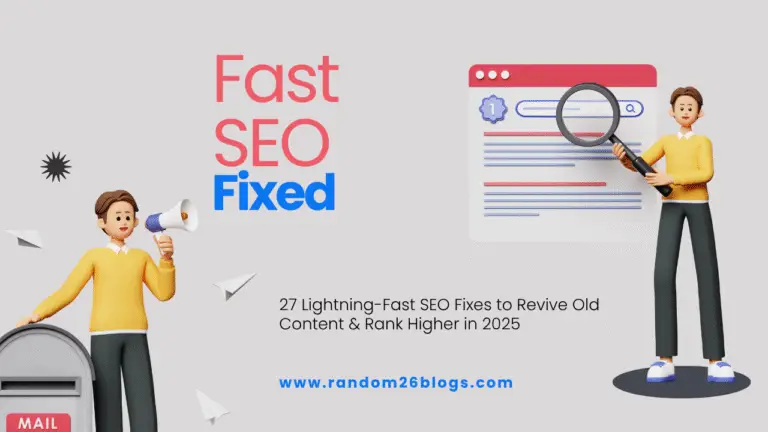
Table of Contents
SEO in 2025 is no longer what it used to be. Google’s AI-driven search updates have changed how content is ranked, making traditional SEO strategies less effective on their own. However, these changes also present new opportunities—if you know what to do.
One of the most significant shifts is the AI Overview feature, which displays a summary of information at the top of search results. This means that even if your blog isn’t ranked #1, it can still be featured prominently in Google’s AI-generated summaries.
So, how do you optimize your content for AI Overview and dominate search rankings in 2025? Let’s dive in.
What is Google’s AI Overview?
Previously, Google search results would simply list links to the top-ranking websites. Now, Google summarizes the best information using AI and displays it at the top before the usual links.
For example, if you search for “best high-protein diet”, instead of just showing blog links, Google’s AI Overview will provide a summary of key points sourced from various blogs. These blogs may not have ranked #1 in traditional SEO, but they appear at the top due to their relevance.
This means that if your content is optimized for AI Overview, you can:
✅ Appear at the top of search results even if your ranking is lower
✅ Get more traffic without relying solely on traditional ranking factors
So, how do you ensure your blog is included in the AI Overview?
Steps to Get Your Blog Featured in AI Overview
To increase your chances of getting featured, follow these four key steps:
1. Find the Right Keywords
AI Overview still depends on ranking blogs, so keyword research is essential. But instead of just targeting high-volume keywords, you need to find keywords that are easy to rank for.
How to Find Keywords for Free
Instead of using paid tools, try these three free keyword research tricks:
- Google Suggestions: Start typing your topic in Google and note the auto-suggested phrases.
- Asterisk Method: Place an asterisk before or after your keyword (e.g., best high-protein diet), and Google will suggest more variations.
- Question-Based Keywords: Add words like “best,” “how,” “why,” “top” to see commonly searched questions.
💡 Pro Tip: Use a Chrome extension to easily copy keyword suggestions and save them in a spreadsheet.
Once you’ve collected keywords, the next step is to check their ranking difficulty.
2. Choose Low-Competition Keywords
Not all keywords are easy to rank for. You need to find keywords with low difficulty scores (preferably below 50).
How to Check Keyword Difficulty
- Use a free keyword difficulty checker (search for one online).
- Copy your keywords and check their difficulty scores.
- Prioritize keywords with low difficulty and high relevance to your topic.
Once you have an easy-to-rank keyword, you’re ready to create your blog post.
3. Create an AI-Friendly Blog Post
Your blog must be structured in a way that Google’s AI can easily understand and use in its summaries. Here’s how:
✅ Answer the main question immediately – Your first paragraph should directly respond to the search query.
✅ Use question-based headings – Example: “What are the benefits of a high-protein diet?”
✅ Provide detailed, well-researched content – AI prefers blogs that offer rich, informative content.
✅ Keep the language simple – Avoid jargon and write for a general audience.
✅ Regularly update your blog – Keep your content fresh to stay relevant in AI Overview.
💡 Bonus Tip: Use an AI writing tool to help structure and optimize your content based on top-ranking articles.
4. Optimize for AI Overview
To maximize your chances of appearing in AI Overview, follow these optimization strategies:
🟢 Use structured data – Adding Schema markup helps Google’s AI understand your content better.
🟢 Include tables & lists – AI Overview prefers structured information, such as bullet points and comparison tables.
🟢 Add relevant images & alt text – AI scans images, so descriptive alt text improves visibility.
🟢 Build authority with high-quality backlinks – If reputable sites link to your blog, AI is more likely to feature it.
Final Thoughts
SEO in 2025 is all about AI-driven content. While traditional SEO tactics still matter, appearing in Google’s AI Overview can give you a huge traffic boost even if your blog isn’t ranked #1.
Recap of Key Strategies:
✅ Find low-competition, high-relevance keywords
✅ Choose a question-based keyword structure
✅ Write clear, detailed, and well-structured content
✅ Optimize for Google AI Overview with structured data and updates
By following these steps, you can stay ahead of SEO trends and drive more traffic to your site. 🚀
👉 What’s your biggest challenge with SEO in 2025? Let me know in the comments!






